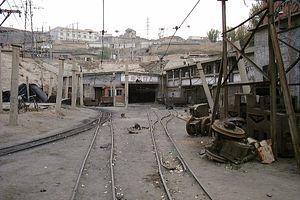With Beijing having adopted the appropriate macroeconomic policies, it is safe to say that the short-term “crisis” the Chinese economy had been facing, represented by a sharp drop in local share prices, has been averted, and the domestic economic situation is now largely positive. Yet this has in turn shifted the spotlight to supply-side problems, longer term issues that need time to properly address. This is most notably evident in the inefficient “zombie companies” that are present primarily in the steel and coal industries. While the issue is attracting a lot of attention in Japan and the rest of the world, few seem to have fully recognized how the structure of the problem with China’s zombie companies closely resembles that of Japan’s “lost two decades.”
The concept of zombie companies originally came into widespread use during the economic debate over the long-term stagnation of the Japanese economy from the 1990s. The paper “Zombie Lending and Depressed Restructuring in Japan” by Ricardo J. Caballero, Takeo Hoshi and Anil K. Kashyap led the way in focusing on the existence of these zombie companies as the cause behind the long-term stagnation of the Japanese economy. The researchers defined a zombie company as “a company with poor productivity and profitability that should have withdrawn from the market but continues to do business only thanks to support from creditors or the government.” They also stressed how the existence of these firms impedes the sound growth of companies and drags down productivity.
Caballero et al. identified zombie companies as those receiving additional loans despite their low productivity and profitability (called “oigashi” in Japanese) and more specifically interest reductions or waivers, and demonstrated empirically how the existence of these zombie companies affects economic performance including capital investment, employment and total factor productivity (TFP). They found that as the percentage of zombie companies in a given industry increases, the expansion of investment and employment is constrained and productivity declines. In July 2016, the National Academy of Development and Strategy, a think tank inside Renmin University of China, released a report on China’s “zombie enterprises.” The report caused a stir when, using the same methods employed by Caballero et al., it indicated that more than fifty percent of the Chinese steel industry is made up of zombie enterprises. The same report cited collusion with local government-owned enterprises, the after-effects of economic stimulus packages following the Lehman Shock, declining foreign demand and the softening of bank loans as among the causes behind the increase in these types of zombie firms.
So, are zombie companies really worsening the performance of the Chinese economy? In short, the effects have manifest as a slump in private sector investment. For instance, the year-on-year growth rate for cumulative fixed asset investment in the private sector for the period from January to July 2016 was 2.1 percent, the lowest rate of growth since statistics began to be published. Although private sector investment has rebounded slightly in response to the government’s investment promotion policies in the months since, a situation where the increase in the money supply and bank lending is not adequately linked to the increase in private sector investment has persisted. Per the research of Caballero et al., this slumping private sector investment is precisely the kind of harmful effect that results from the continued existence of many zombie companies.
What policies, then, should be used to address the declining productivity of these zombie companies? One approach would be liquidation – that is, to mercilessly force zombie companies with low profitability and large debts to exit the market, dispose of the debt and ensure that funds are allocated to more productive firms. However, the drastic measures to reorganize debt through a liquidation approach could trigger sweeping lay-offs and cause a sharp rise in the unemployment rate. This could have the unintended effect of actually pushing productivity down further due to human resources not being effectively utilized.
Let’s take another look back at the circumstances that surrounded the zombie company phenomenon in Japan. As much research has pointed out, by the time of the Koizumi administration, many companies that until then had been performing poorly and were designated “zombie firms” had gradually recovered. Studies by Junichi Nakamura and Shinichi Fukuda have shown that in addition to those companies undertaking their own effective restructuring, improvements to the macroeconomic environment in Japan and overseas, more specifically increased external demand against the backdrop of global economic growth from 2002 onward, provided the tailwind that helped zombie companies recover. In other words, under deflationary conditions where there is insufficient domestic and overseas demand, the more drastic the situation, the greater the percentage of zombie companies and resultant harmful effects.
Even given the fact that some degree of restructuring is essential for raising supply-side productivity, it will always need to be combined with expansionary monetary and fiscal policies to temper the demand-side shock. This appears to be the right prescription for China’s zombie company problem, considering the lessons learned in Japan. In any case, when looking for hints on where the Chinese economy currently stands, reflecting on the policy debates that occurred during Japan’s “lost two decades” could prove more significant than it currently seems.
Kai Kajitani is Associate Professor, Graduate School of Economics, Kobe University.

































